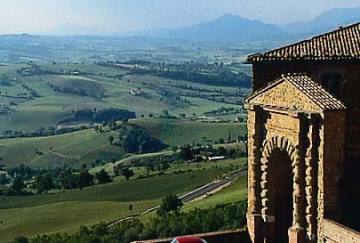|
*See this page for information on earthquake damage in 2016 in this area.
Poised on a ridge between two river valleys, this small but impressive hill town on the border between central Marche and Umbria boasts not only a bishop
but also a university.

Its centro storico , or old centre, has seen little change
over the last few centuries, leaving it a particularly attractive sight, and the opulence of the architecture is all the more impressive for the fact that the town can claim a mere 7,000 inhabitants.
The town's venerable history goes back to Neolithic times. The Romans, Goths, Byzantines and Lombards all
left their print on the place and under Charlamagne it was made the capital of the Marca of Camerino.
Its heyday, however, was under the feudal lords of the Da Varanno family, who in Renaissance times seemed to be related to all the great noble families of Italy. Things
came to a sticky end, however, for the last of the Da Varanno rulers, Giulio Cesare - he and three of his sons were strangled in 1512 under the orders of the infamous Cesare Borgia.
Most of Camerino was built during the enlightened rule of the Da Varano family between the 14th and 16th centuries when its court drew artists and scholars from across Italy.
The narrow main street takes you from the town's fortress to the principal square, Piazza Cavour, around which stand the Cathedral, the Archbishop's Palace and
the Ducal Palace, now the University. Over it all watches a fine statue of Pope Sixtus V dating from 1587.
The porticoed courtyard of the Ducal Palace is partly attributed to the great 15thC architect Baccio Pontelli. From it leads a splendid balcony with great views of the
Sibillini Mountains.
The grand architectural complex of San Domenico, built between the 13th and 16th centuries, has been
restored and now houses a choice collection of works from the Camerino School of painting.
Another of Camerino's gems is the Teatro Marchetti off the courtyard in the Palazzo Comunale. Built in 1856, it has recently been restored and put back into use.
|